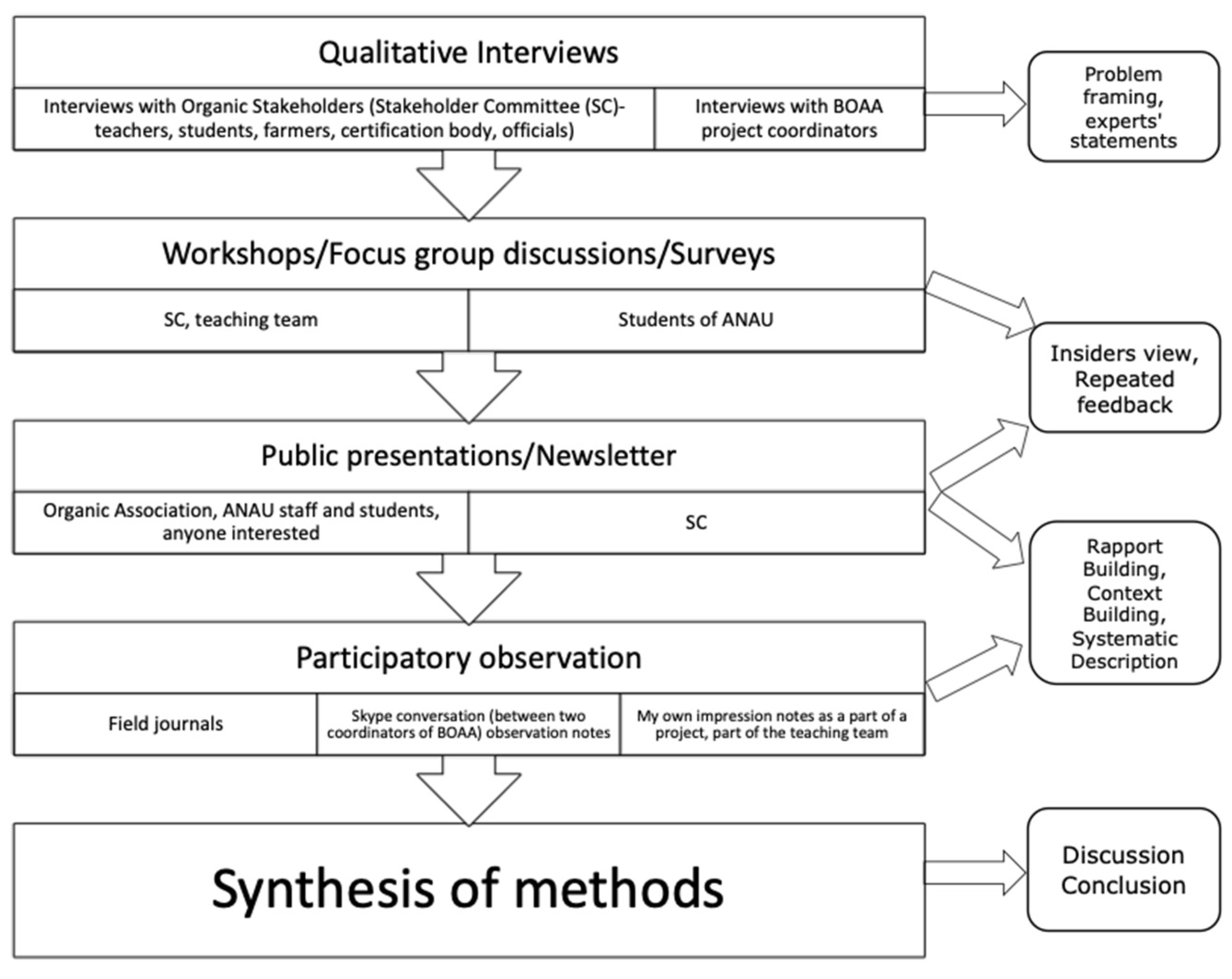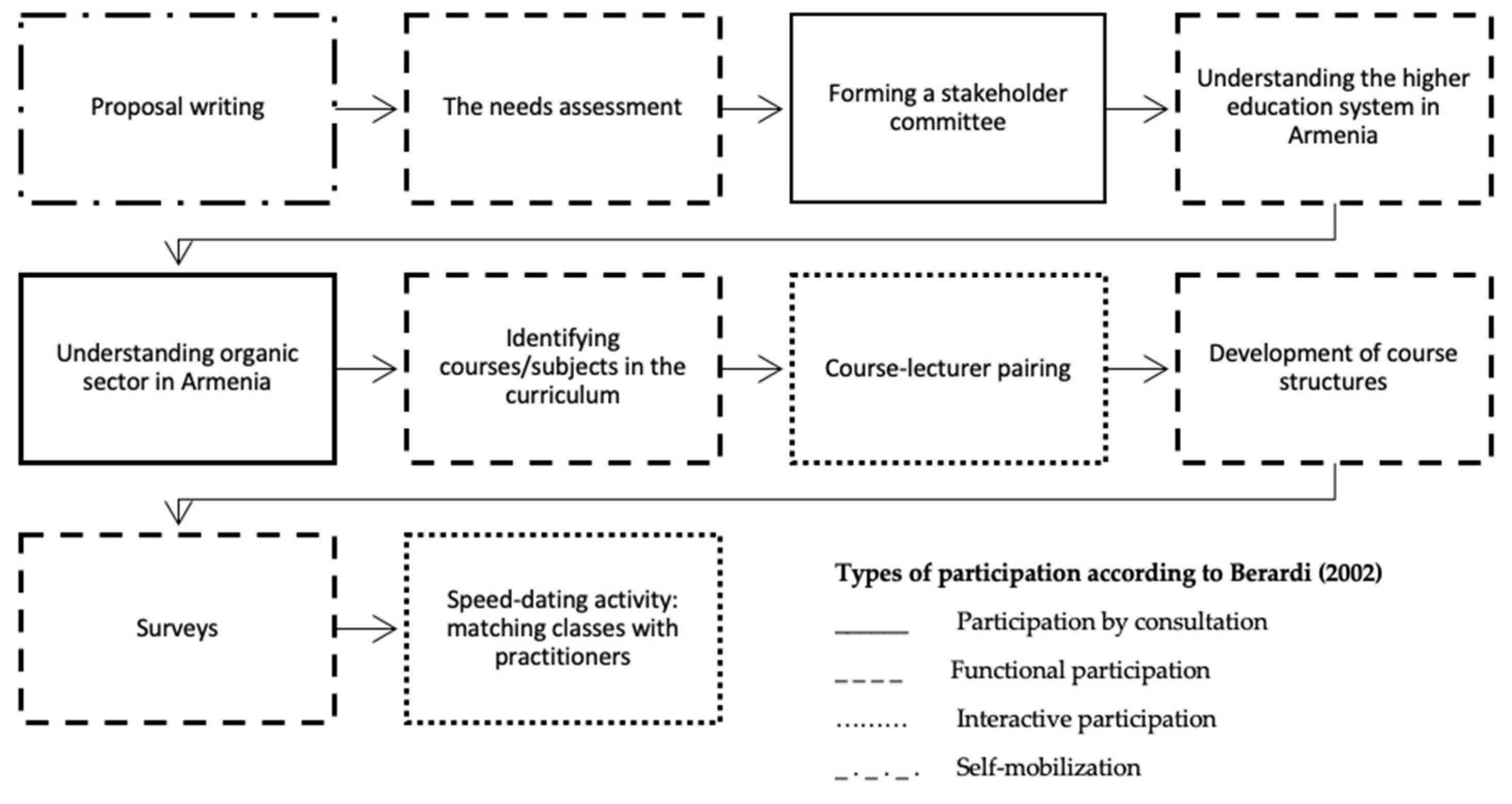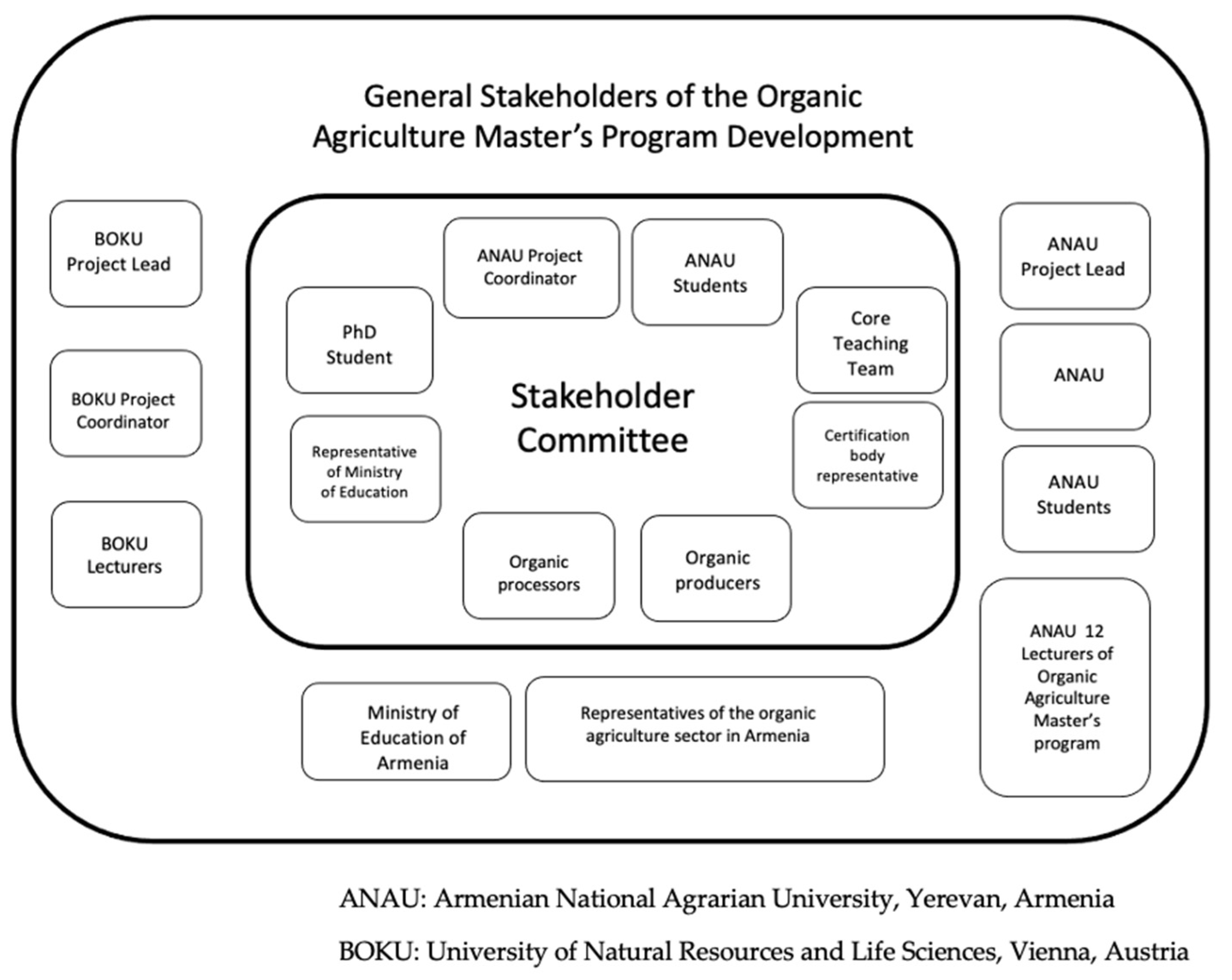Participation in Higher Education Curricula Development in Armenia and Possible Effects for the Labour Market—The Case of an “Organic Agriculture” Master’s Program
Abstract
:1. Introduction
- To describe the process of participatory curriculum development using the case of the Organic Agriculture Master’s program in Armenia;
- To understand the role of the stakeholders in participatory curriculum development—to fulfil the gap of organic professionals in the labour market; and
- To illustrate what participation in higher education has to offer to the current Armenian labour market through the Armenian Organic Agriculture Master’s program.
1.1. Background
1.1.1. Challenges of the Armenian Labour Market
1.1.2. Participatory Curriculum Development (PCD); towards Student-Centred Higher Education and “Real-World” Relevance
1.2. The Case: Organic Agriculture Master’s Program at the Armenian National Agrarian University
2. Theoretical Framework
- →
- Participation by consultation, when participants are usually experts and they are being interviewed, and the project team has no obligation to follow ideas of interviewees;
- →
- Functional participation, when usually external participants are part of the project and objectives are identified in advance;
- →
- Interactive participation, when participants are also decision makers and action-plan developers, and they are actually participating in data analysis as well; and
- →
- Self-mobilization, when participants initiate a project themselves independently.
3. Materials and Methods
4. Results
4.1. Conceptual Mapping of the Participatory Curriculum Development
“There is need for a revolution in curriculum development.”Lecturer interview N2
- University representatives:
- Two students from previous focus groups were elected amongst themselves to represent their voice in the stakeholder committee;
- Three lecturers (a so-called core team of lecturers) representing teaching staff of the master’s program, who also were knowledgeable about administrative requirements of the University regarding curriculum.
- Organic production representatives:
- Three organic processors and two producers who wanted to shift to organic.
- Certification body representative:
- Ecoglobe LLC—the only national organic certification organization—was represented by either the head of the organization or by the head of one of its departments.
- Representative from the Ministry of Education:
- One member to fulfil the requirements of the curriculum license.
- Project team:
- Project coordination from ANAU;
- The PhD researcher.
4.2. Effective Collaboration Possibilities between ANAU and the Agricultural Sector for Graduates’ Better Employability
- Creating a platform that is accessible to all stakeholders; this would first of all build a network of the organic stakeholders, and will further build a solid base for a dialogue between university staff and practitioners;
- Planning the cooperation at least one semester ahead, taking into account the needs and opportunities of both sides;
- Mutual visits, invited lecturers, presentation of success stories (for theoretical, methodological, and practical inputs); the university should not be isolated from the “real world”, and therefore visits of the lecturers and students to the farms and practitioners’ visits to the classroom should be on a regular basis;
- Legal long-term regulation of collaboration (laws, agreements, contracts). In order to have a long-term collaboration, a state regulatory framework is needed; for instance, it should be stated in the labour codex on which regulatory basis the students can be paid for their internships (the income tax paid by the learner to the state should be returned to the student for paying a tuition fee), or how the practitioner will be taxed for employing a student, etc. Agreements or contracts need to be signed between the university and the practitioner for more reliable collaboration.
4.3. The Possible Effect of Participatory Curriculum Development in Higher Education on the Labour Market in Armenia
- ○
- “Education takes time, so it is not possible to have a rapid effect”;
- ○
- “The sector of organic agriculture is rather small in Armenia, so the effect on the labour market will not be significant, either”;
- ○
- “The awareness of organic agricultural products is quite low; there is still work that needs to be done here”.
- ○
- In the export field of organic products;
- ○
- In the field of consultancy; not only in the production of organic produce, but also in organic certification services; and
- ○
- When students become practitioners themselves and use their own knowledge for producing organic products on their own.
5. Discussion
“No change is easy, but we must do it if we want to change something in our educational quality.”Focus group with organic stakeholders of Armenia
Lessons Learned
6. Conclusions
Supplementary Materials
Author Contributions
Funding
Informed Consent Statement
Data Availability Statement
Conflicts of Interest
Abbreviations
| ANAU | Armenian National Agrarian University, Yerevan, Armenia |
| BOKU | University of Natural Resources and Life Sciences, Vienna, Austria |
| PAR | Participatory action research |
| PCD | Participatory curriculum development |
Glossary
| Course structure | The structure of a single subject within a curriculum, including topics, teaching methods, literature, and learning outcomes. |
| Course | A separate subject within the Organic Agriculture Master’s program curriculum. |
| Curriculum | An entire educational program, such as the Organic Agriculture Master’s program. |
| Curriculum development | Includes the initiating, design, and implementation of the curriculum. |
| PCD | Includes the initiating, design, and implementation of the curriculum in which participatory methods dominate. |
| Stakeholders | Students, farmers, organic producers, lecturers, organic certification body representatives, officials, and “Organic Armenia” Association representatives. |
References
- Bardak, Ummuhan, Jesus Alquezar Sabadie, Anasta Fetsi, and Constantin Zaman. 2011. Labour Markets and Employability: Trends and Challenges in Armenia, Azerbaijan, Belarus, Georgia, Republic of Moldova and Ukraine. Turin: European Training Foundation. [Google Scholar]
- Berardi, Gigi. 2002. Commentary on the challenge to change: Participatory research and professional realities. Society &Natural Resources 15: 847–52. [Google Scholar]
- Bergold, Jarg, and Stefan Thomas. 2012. Participatory research methods: A methodological approach in motion. Historical Social Research/Historische Sozialforschung 37: 191–222. [Google Scholar]
- Bolander Laksov, Klara, Agnes Elmberger, Matilda Liljedahl, and Erik Björck. 2020. Shifting to Team-based Faculty Development: A Programme designed to facilitate change in Medical Education. Higher Education Research & Development, 1–15. [Google Scholar] [CrossRef]
- Breitbart, Myrna Margulies. 2010. Participatory Research Methods 11. In Key Methods in Geography. Thousand Oaks: Sage, pp. 141–147. [Google Scholar]
- Burke, Penny Jane. 2013. The Right to Higher Education: Beyond Widening Participation. London: Routledge. [Google Scholar] [CrossRef]
- Caspari, Aleksandra. 2006. Partizipative Evaluationsmethoden–zur Entmystifizierung eines Begriffs in der Entwicklungszusammenarbeit. Qualitative Evaluationsforschung. Konzepte, Methoden, Umsetzungen, 365–84. [Google Scholar]
- Chambers, Robert. 1994. Participatory rural appraisal (PRA): Analysis of experience. World Development 22: 1253–68. [Google Scholar] [CrossRef]
- Chambers, Robert. 2002. Relaxed and Participatory Appraisal: Notes on Practical Approaches and Methods for Participants in PRA/PLA-Related Familiarisation Workshops. Brighton: Participation Group, Institute of Development Studies, University of Sussex. [Google Scholar]
- Cook, Tina. 2012. Where participatory approaches meet pragmatism in funded (health) research: The challenge of finding meaningful spaces. Forum: Qualitative Social Research. [Google Scholar] [CrossRef]
- Cornwall, Andrea, and Karen Brock. 2005. Beyond Buzzwords “Poverty Reduction”,“Participation” and “Empowerment” in Development Policy. Geneva: UNRISD. [Google Scholar]
- Dahal, Meera. 2017. Reinventing Higher Education: Toward Participatory and Sustainable Development. Bangkok: UNESCO. [Google Scholar]
- Dentith, Audrey, Lynda Measor, and Mychael P. O’Malley. 2012. The research imagination amid dilemmas of engaging young people in critical participatory work. Forum Qualitative Sozialforschung/Forum: Qualitative Social Research 13. [Google Scholar] [CrossRef]
- Goeke, Stephanie, and Dagmar Kubanski. 2012. Menschen mit Behinderungen als GrenzgängerInnen im Akademischen Raum: Chancen partizipatorischer Forschung. Forum Qualitative Sozialforschung/Forum: Qualitative Social Research 13: 6. [Google Scholar]
- Goldwasser, Matthew. 1992. School Restructuring and the Gap between Policy and Practice. Boulder: School of Education, University of Colorado. [Google Scholar]
- Hartwell, Christopher. 2010. Employment protection legislation and labor markets in transition: Assessing the effects of the labor code in Armenia. The European Journal of Comparative Economics 7: 413–45. [Google Scholar]
- Heyneman, Stephen. 2010. A comment on the changes in higher education in the former Soviet Union. European Education 42: 76–87. [Google Scholar] [CrossRef]
- Hovakimyan, Hasmik, Milena Klimek, Bernhard Freyer, and Ruben Hayrapetyan. 2021. Sustainable Shift from Centralized to Participatory Higher Education in Post-Soviet Countries: A Systematic Literature Review. Sustainability 13: 5536. [Google Scholar] [CrossRef]
- ICARE. 2016. Stocktaking of Policies and Legal Framework for Organic Agriculture: Armenia. Yerevan: ICARE, p. 80. [Google Scholar]
- Ionescu, Alina Mariuca, and A. I. Cuza. 2012. How does education affect labour market outcomes. Review of Applied Socio-Economic Research 4: 130–44. [Google Scholar]
- Karakhanyan, Susanna Yuri. 2011. Reforming Higher Education in a Post-Soviet Context: The Case of Armenia. [Sl: sn]. Saarbrucken: LAP LAMBERT Academic Publishing. [Google Scholar]
- Karakhanyan, Susanna Yuri, Klaas van Veen, and Theo C.M. Bergen. 2012. What do leaders think? Reflections on the implementation of higher education reforms in Armenia. Educational Management Administration & Leadership 40: 752–71. [Google Scholar]
- OECD. 2018. The Future of Education and Skills: Education 2030. Education Working Papers. Paris: Organisation for Economic Cooperation and Development. [Google Scholar]
- Patrucco, Andrea Stefano, Elena Pellizzoni, and Tommaso Buganza. 2017. The design process of corporate universities: A stakeholder approach. Journal of Workplace Learning 29. [Google Scholar] [CrossRef] [Green Version]
- Rosenblatt, Z., P. J. den Brok, Th Wubbels, and A. Menlo. 2006. Teacher involvement in change: A cross-cultural study of principals’ and teachers’ perspectives. In The World of Educational Quality. Washington, DC: American Educational Research Association (AERA). [Google Scholar]
- Serrière, Nicolas. 2014. Labour Market Transitions of Young Women and Men in Armenia. Geneva: ILO. [Google Scholar]
- Shahverdyan, Anush. 2009. The Mismatch of Higher education (supply) and the labor market (demand). Kantegh: A Collection of Scientific Articles 3: 249–54. (In Armenian). [Google Scholar]



| Teaching/Learning Methods | Participants’ Choice (with Possibility to Choose More than One Answer) | |
|---|---|---|
| 1 | Practical classes | 75% |
| 2 | Real case studies | 70% |
| 3 | Group discussions | 60% |
| 4 | Presentations | 55% |
| 5 | Learning by doing | 50% |
| 6 | Lecturing | 37.5% |
| 7 | Online learning | 5% |
| 8 | Other | 2% |
Publisher’s Note: MDPI stays neutral with regard to jurisdictional claims in published maps and institutional affiliations. |
© 2021 by the authors. Licensee MDPI, Basel, Switzerland. This article is an open access article distributed under the terms and conditions of the Creative Commons Attribution (CC BY) license (https://creativecommons.org/licenses/by/4.0/).
Share and Cite
Hovakimyan, H.; Klimek, M.; Freyer, B.; Vogel, S. Participation in Higher Education Curricula Development in Armenia and Possible Effects for the Labour Market—The Case of an “Organic Agriculture” Master’s Program. Soc. Sci. 2021, 10, 331. https://doi.org/10.3390/socsci10090331
Hovakimyan H, Klimek M, Freyer B, Vogel S. Participation in Higher Education Curricula Development in Armenia and Possible Effects for the Labour Market—The Case of an “Organic Agriculture” Master’s Program. Social Sciences. 2021; 10(9):331. https://doi.org/10.3390/socsci10090331
Chicago/Turabian StyleHovakimyan, Hasmik, Milena Klimek, Bernhard Freyer, and Stefan Vogel. 2021. "Participation in Higher Education Curricula Development in Armenia and Possible Effects for the Labour Market—The Case of an “Organic Agriculture” Master’s Program" Social Sciences 10, no. 9: 331. https://doi.org/10.3390/socsci10090331
APA StyleHovakimyan, H., Klimek, M., Freyer, B., & Vogel, S. (2021). Participation in Higher Education Curricula Development in Armenia and Possible Effects for the Labour Market—The Case of an “Organic Agriculture” Master’s Program. Social Sciences, 10(9), 331. https://doi.org/10.3390/socsci10090331






